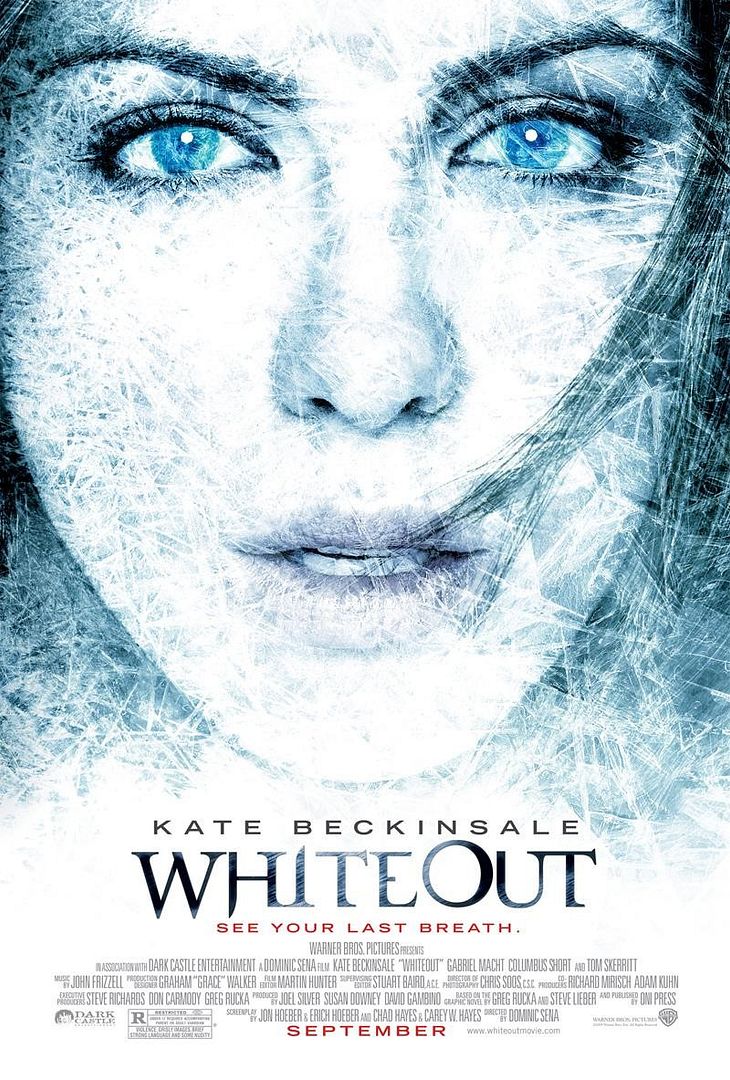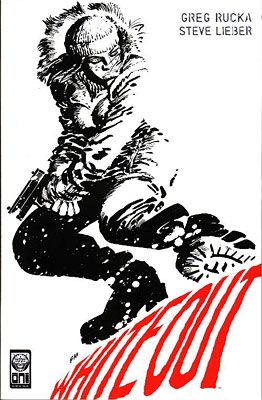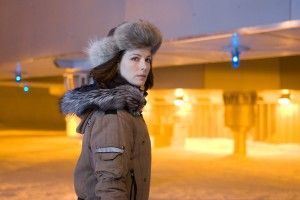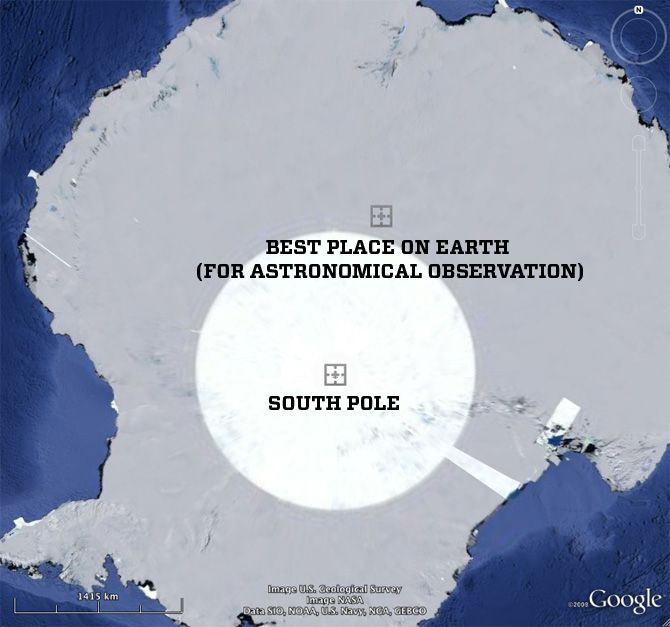
In a recent interview with ScriptPhD.com, Watchmen screenwriter Alex Tse described Hollywood’s recent spate of comic book and graphic novel adaptations as jumping on a bandwagon. So let’s continue the momentum and hop aboard the South Pole Express to Warner Brothers’ Kate Beckinsale-starring remake of the classic graphic novel Whiteout by Greg Rucka and Steve Lieber. ScriptPhD.com reviews this cool-as-ice thriller and provides some real-world gripping tales of scientific heroism in Antarctica under the jump.
Review: Whiteout
ScriptPhD Grade: B
Deep in the blinding chill of the whipping Antarctic winds and snow flurries, with temperatures at -120 degrees and winds at 100 miles per hour, a Russian cargo plane carries a crew and mysterious payload. Its flight and mission are aborted by a rampage that kills every member aboard, forever burying the plane and its secrets. That was 1957. This is now. Assigned to the South Pole’s Amundsen-Scott research station, U.S. Marshall Carrie Stetko (Kate Beckinsale) is wrapping up her Department of Justice duties and getting ready to hand in her badge before the oncoming “whiteout”, an unholy convergence of weather events that results in a six-month winter of darkness. Inconveniently for Stetko, days before the last of the planes are to leave the station, a grisly murder is discovered, Antarctica’s first. Delving deeper into the mystery, and putting her own life into danger, Stetko unravels motivations leading all the way back to the Russian cargo plane. With the help of her friend and mentor, the station’s on-board doctor (an avuncular Tom Skerrit), UN investigator Robert Pryce (Gabriel Macht), and fiery pilot Delfy (scene-stealer Columbus Short), Carrie must battle the haunting demons of her past and the harsh conditions of the present to answer the two questions that will capture the killer. What was on the cargo plane that was worth killing for? And who can she trust?

Seeking to evoke the realism of the cold, barren Antarctic, director Dominic Sena shot the film’s exteriors in subzero temperatures in Manitoba, Canada, a point reiterated vocally by the stars at the press junket. Sweeping cinematography of the stunningly beautiful landscapes is one of Whiteout‘s high points. However, Sena’s camerawork seems to serve no more than the dual purpose of pointing out that the South Pole is oh-so-very cold and that Kate Beckinsale is oh-so-very hot. (A gratuitous shower scene towards the film’s beginning evinced an audible groan of disbelief from the press corps.) That Beckinsale has a smokin’ bod is apparently essential to absorbing this labyrinthine tale. “What I found intriguing about the story and about Carrie Stetko is how human and flawed she is,” said Beckinsale. “Because you don’t know her backstory, you don’t know what she is capable of until you see events unfold. How damaged is she? Are her instincts still good and will they carry her through or will they fail her again?” Sadly, Ms. Beckinsale could not translate this wonder and intrigue into credible acting. Her staid, underwhelming performance turns a rare (for the world of graphic novels) strong leading heroine into a forgettable victim. Surrounded by a cluster of credible, if underdeveloped, side characters, the relationships and secondary plots feel like anemic distractions from an already weak premise. A tease of romance between Stetko and UN investigator Pryce is just that, because they haven’t had time to solidify a true bond. Likewise with colleagues Doc Fury and the pilot Delfy–by the time their characters figure into the unfolding of events, no one cares. Flashbacks to a previous partner’s betrayal and murder by Carrie (in a rather clever meteorological juxtaposition between scorching Miami and frosty Antarctica), significantly explored in the graphic novel, never finds satisfactory resolution in the movie. To make matters worse, many of the comic book elements that contributed to the book’s success simply don’t translate to the silver screen. A masked pick axe-wielding psychopath, for example, designed elicit page-turning fear, in the film seems anachronistic and inappropriately humorous. There is also the controversy over several elements changed from the novel, most notably the gender of Stetko’s UN agent partner, originally a female in the book, with whom Stetko had nevertheless become . . .close.

Despite its shortcomings, Whiteout still has noteworthy merits, not the least of which are subtle, appreciated nods to science organizations NOAA and the National Science Foundation. For one thing, the movie never scrimps on the action and thrills. A few of the chase scenes between Stetko and her would-be assailant, amplified by the blinding, debilitating chill, are downright gripping. With an unidentified killer afoot in a confined space, a few of Beckinsale’s solo scenes evoke the psychological suspense of classic film noir. Much of that was achieved through Sena’s commitment to shooting in authentic locales and conditions. “We wanted to lay out clearly what the temperatures are, how quickly a person can get frostbite or die from exposure. It’s all there and it’s all true,” said the filmmakers. Indeed, the unforgiving conditions are a character unto themselves, contributing both to the plot evolution and action sequences. Adds Beckinsale, “The action is based in reality and I think that will make it more intense for audiences because they might imagine what they would do in the same situation.” Finally, despite veering towards some predictable plot points along the way, Whiteout does culminate in a genuinely surprising ending that will keep you guessing. After reading the bookseeing the movie and digesting the ending, the tagline “See Your Last Breath” will make much more sense.
The bottom line is that fans of Ms. Beckinsale, the original graphic novel, or those simply looking for a mindless cinematic weekend escape will be suitably pleased with this perfectly adequate by-the-numbers thriller. However, fans wishing to experience the magic and suspense of Whiteout with all the nuance and character depth that the story necessitates are better off sticking with Rucka and Lieber’s comic masterpiece.
Whiteout opens this Friday, September 11th in theatres nationwide.
South Pole Science
The Amundsen-Scott South Pole Station is the southernmost continually inhabited place on the planet. Research, the primary purpose of the station, includes glaciology, geophysics, meteorology, upper atmosphere physics, astronomy, astrophysics, and biomedical studies. As depicted in the film, scientists (and other crew members) primarily inhabit the station from late October to mid-February, leaving a minimal crew during the “winter over” Whiteout months. For a tour of the Station by researchers working on the South Pole telescope, check out this video:
Want a real dose of Hollywood terror on the South Pole? Check out the story of heroic Doctor Jerri Nielsen FitzGerald. Answering a call to serve as the only doctor at the NSF’s Amundson-Scott research station, Dr. Nielsen, an emergency room physician, soon found herself trapped at the station because sub-100 degree temperatures turned fuel gelatinous, thus making flights in or out of the station impossible. It was right then that she discovered a lump in her breast, and had to rely on computers, satellite imaging and teleconferences with oncologists back in the United States. Terrifyingly, because she was the only trained physician at the station, Dr. Nielsen had to get help from her colleagues for every procedure–a welder first practiced on an apple before using a needle to perform her biopsy, a maintenance worker prepared laboratory slides and other samples, and computer scientists aided with transmissions of data for analysis and chemotheraphy treatment, which was airdropped to the station. Finally, as temperatures began to thaw that Spring, she was rescued by the National Guard. Dr. Nielsen documented her harrowing story in the autobiography “Ice Bound: A Doctor’s Incredible Battle for Survival at the South Pole”, as well as a CBS movie of the same title starring Susan Sarandon. Sadly, Dr. Nielsen passed away earlier this summer, but her bravery, courage, and survival are immortalized.

The next wave of research on the South Pole? Stargazing. Scientists have identified the perfect spot, known as Ridge A, located in the Antarctic interior [see picture above]. Why is it so perfect? Scientists combined all the factors that influence astronomy–cloud cover, temperature, sky-brightness, water vapor, wind speeds and atmospheric turbulence–and determined where they converge most auspiciously. “The astronomical images taken at Ridge A should be at least three times sharper than at the best sites currently used by astronomers,” said Will Saunders, an astronomer at the Anglo-Australian Observatory and visiting professor to UNSW, in a press release. “Because the sky there is so much darker and drier, it means that a modestly-sized telescope there would be as powerful as the largest telescopes anywhere else on earth.” The bad news? It’s so inhospitable to human existence, no human has ever set foot on the space. Well, no discovery is perfect. A similar viewing station nearby, the Dome A PLATO observatory functions year round robotically, without any human presence, and could serve as a model for Ridge A.
But until then, we have Hollywood.
~*ScriptPhD*~
*****************
Follow ScriptPhD.com on Twitter and our Facebook page. Subscribe to email post updates on our home page.